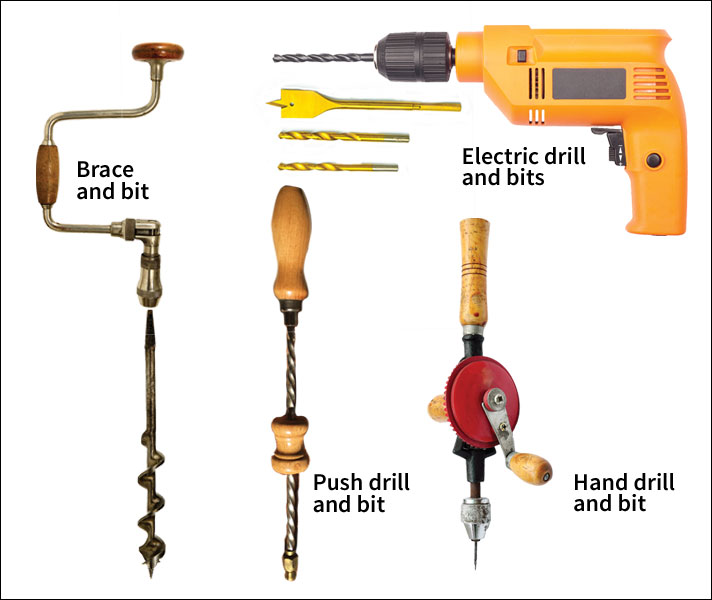Drill is a tool used to bore holes into a variety of materials. These materials range from soft soil to hard rock, metal, plastics, and concrete. Drills are widely used to bore holes into wood or metal so screws or other fasteners can be inserted. Construction workers use drills to break up pavement and to dig foundations for buildings. Energy companies rely on drills to dig for oil and natural gas and to get rock samples. Dentists use small air-powered or electric drills to remove tooth decay.
Some drills are small and hand-operated. There are also handheld power drills. Drills called drill presses are mounted on tables or stand on the floor. Large drills must be mounted on masts supported by trucks or rigs.
The first drills were slender pieces of wood with points of sharp rock bound to them. They were invented about 4000 B.C. The Italian artist and inventor Leonardo da Vinci designed the first mechanical drill about A.D. 1495. The first practical handheld power drill was patented in 1917. This article describes tools that drill metal, wood, and rock.
Metal drills
turn a slender steel rod called a bit. Bits are removable and come in various sizes to make different-sized holes. One end of the bit fits into the drill. The other end of the bit has one or more cutting edges called lips. The lips can be either a permanent part of the bit or a detachable piece called an insert. When the drill turns the bit at high speed, the lips cut into the metal to make a hole. Bits also have grooves called flutes. As the bit rotates, flutes direct metal shavings out of the hole so the hole does not clog and cause the drill to jam. Flutes also allow cooling liquids to flow into the hole to prevent the bit from overheating.

Most metal drill bits are twist bits. Twist bits have two or more lips and two or more spiraling flutes. A special bit called a spade bit is used in many manufacturing processes to drill deep holes. A spade bit is a flat blade with one lip. The bit is clamped in a holder before it is fitted into the drill.
Wood drills
usually use specially fluted twist bits called auger bits. An auger bit is easy to keep centered because it has a screwlike tip called a feed screw. Auger bits called Jennings bits, with two flutes, are used in hand-operated drills. Handheld power drills take auger bits called power bits, which have one spiraling flute.
Rock drills
are power drills that use a hammering action, a plowing action, or both. A paving breaker, also called a jackhammer, rapidly hammers a chisellike bit into such materials as concrete and blacktop. Jackhammers are often used to break up roads, wreck buildings, and dig trenches (see Pneumatic tool).
Drills that plow without hammering are called rotary drills. Among rotary bits are fishtails, which have hardened carbon lips, and diamond bits. Diamond bits are studded with points of diamond to cut hard rock. They are often used in small, handheld drills to get samples of underground rock or ore.
Rotary drills called augers have steel screw threads. Augers are often used to drill oil wells (see Petroleum (Drilling for petroleum)).
